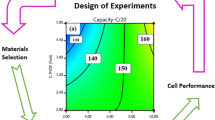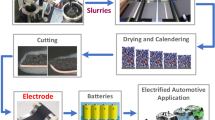Abstract
The initial efficiency is a very important criterion for carbon anode material of Li-ion battery. The relationship between initial efficiency and structure parameters of carbon anode material of Li-ion battery was investigated by an artificial intelligence approach called Random Forests using D 10, D 50, D 90, BET specific surface area and TP density as inputs, initial efficiency as output. The results give good classification performance with 91% accuracy. The variable importance analysis results show the impact of 5 variables on the initial efficiency descends in the order of D 90, TP density, BET specific surface area, D 50 and D 10; smaller D 90 and larger TP density have positive impact on initial efficiency. The contribution of BET specific surface area on classification is only 18.74%, which indicates the shortcoming of BET specific surface area as a widely used parameter for initial efficiency evaluation.
Similar content being viewed by others
References
PELED E. The electrochemical behavior of alkali and alkaline earth metals in nonaqueous battery systems: The solid electrolyte interphase model[J]. Journal of the Electrochemical Society, 1979, 126(12): 2047–2051.
WU Yu-ping, DAI Xiao-bin, MA Jun-qi, CHEN Yu-jiang. Li-ion battery-Application and practice[M]. Beijing: Chemical Industry Press, 2004. (in Chinese)
YUICHI S, TAKESHI N, KOICHI K, TAKANOBU K, AKIRA Y. Particle-size effect of carbon powders on the discharge capacity of lithium ion batteries[J]. Journal of Power Sources, 1998, 75(2): 271–277.
KATIA G, ANNIE F, SERGE F, MICHEL C, BERNARD S, PHILIPPE B. Effect of graphite crystal structure on lithium electrochemical intercalation[J]. Journal of Electrochemical Society, 1999, 146(10): 3660–3665.
ZAGHIB K, NADEAU G, KINOSHITAB K. Effect of graphite particle size on irreversible capacity loss[J]. Journal of Electrochemical Society, 2000, 147(6): 2110–2115.
ZHOU You-yuan, LI Xin-hai, GUO Hua-jun, WANG Zhi-xing, YANG Yong, XIE Qiao-ling. Modification of natural graphite using pitch through dynamical melt-carbonization[J]. Journal of Central South University of Technology, 2007, 14(5): 651–655.
ANDREW R W. Statistical pattern recognition[M]. 2nd ed. WANG Ping, YANG Pei-long, LUO Yong-xin. Beijing: Publishing House of Electronic Industry, 2004: 178–182.
BREIMAN L. Random Forests[J]. Machine Learning, 2001, 45(1): 5–32.
RAJARSHI G, PETER C J. Development of linear, ensemble, and nonlinear models for the prediction and interpretation of the biological activity of a set of PDGFR Inhibitors[J]. J Chem Inf Comput Sci, 2004, 44(6): 2179–2189.
LI S Q, FEDOROWICZ A, SINGH H, SODERHOLM S C. Application of the Random Forest method in studies of local lymph node assay based skin sensitization data[J]. J Chem Inf Model, 2005, 45(4): 952–964.
SVETNIK V, WANG T, TONG C, ANDY L, ROBERT P S, SONG Q H. Boosting: An ensemble learning tool for compound classification and QSAR modeling[J]. J Chem Inf Model, 2005, 45(4): 786–799.
NOGARAJAN G S, VAN Z J W, SPOTNITZ R M. A mathematical model for intercalation electrode behavior I: Effect of particle-size distribution on discharge capacity[J]. Journal of Electrochemical Society, 1998, 145(3): 771–779.
ZAGHIB K, SONG X, GUERFI A, KOSTECHKI R, KINOSHIT K. Effect of particle morphology on lithium intercalation rates in natural graphite[J]. Journal of Power Sources, 2003, 124(2): 505–512.
YANG Yong, PENG Wen-jie, GUO Hua-jun, WANG Zhi-xing, LI Xin-hai, ZHOU You-yuan, LIU Yun-jian. Effects of modification on performance of natural graphite coated by SiO2 for anode of lithium ion butteries[J]. Trans Nonferrous Met Soc China, 2007, 17(6): 1339–1342.
LÜ Chun-ping, ZHAO Xin-bing, CAO Gao-shao, ZHU Tie-jun. Effects of graphite on Zn-Sb alloys as anode materials for lithium ion batteries [J]. Trans Nonferrous Met Soc China, 2000, 10(2): 204–208.
Author information
Authors and Affiliations
Corresponding author
Additional information
Foundation item: Project(2001AA501433) supported by the National High-Tech Research and Development Program of China
Rights and permissions
About this article
Cite this article
Shen, Jb., Tang, Yg., Liang, Yz. et al. Relationship between initial efficiency and structure parameters of carbon anode material for Li-ion battery. J. Cent. South Univ. Technol. 15, 484–487 (2008). https://doi.org/10.1007/s11771-008-0091-y
Received:
Accepted:
Published:
Issue Date:
DOI: https://doi.org/10.1007/s11771-008-0091-y




